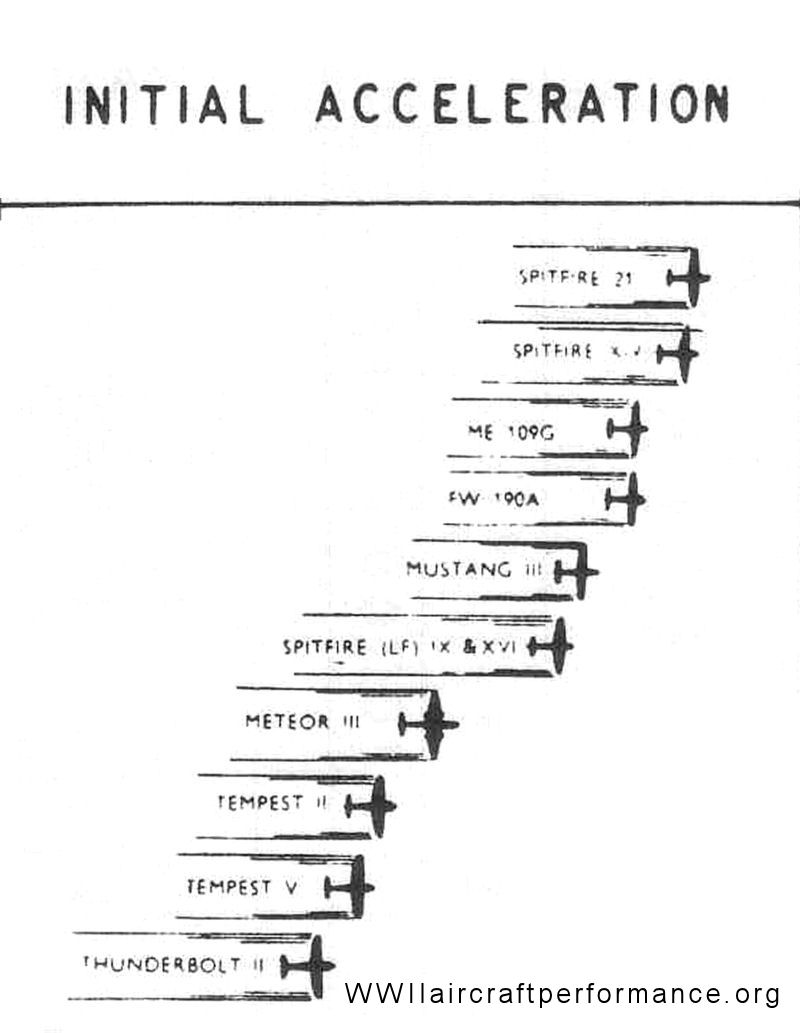Originally posted by mw
Pierre Clostermann (Free French) wrote of the Tempest:
It had a thoroughbred look and, in spite of the big radiator which gave it an angry and wilful appearance, it was astonishingly slender. It was very heavy, all of seven tons. Thanks to its 2,400 h.p. engine it had a considerable margin of excess power and its acceleration was phenomenal.
I routinely find myself questioning Clostermann's statements. Like Brown, I think he has a tendency towards overstating. However, in this case I think he's not far off.
First, let me use an image from one of your documents. It is not data in the sense that it defines acceleration. It does, however, establish a general ranking in terms of relativity. So, is this accurate? We will see.

We can calculate a reasonably close rate of acceleration if we can determine several unknowns. These are propeller efficency and drag. We can use a constant for the the prop, but may have to estimate drag.
We can calculate the approximate thrust available at a given speed. To do this, we must estimate the efficiency of the propeller. If we begin at 150 mph, a typical WWII prop will demonstrate approximately 70% efficiency. If this is applied to all examples, it becomes a fair, if not perfectly accurate method. Note that 2,400 hp in the Tempest is at 11 lb boost.
Thus, for the Tempest:
375 x .7 x 2,400 / 150 = 4,200 lb of thrust.
For the Spitfire Mk.XIV:
375 x .7 x 2050 / 150 = 3,588 lb of thrust.
Now that we know the available thrust, we can calculate acceleration in feet per second, per second. Of course, we need to know what the total drag is. This can also be calculated or obtained from a reliable source. In this case, I'm going to use what I believe are close estimates.
Total drag for the Tempest: 1,350 lb
Total drag for the Spit XIV: 990 lb
Thus, thrust - drag / mass (in slugs) = initial acceleration in feet per second, per second.
Tempest: 4200 - 1350 / (11480/32.2) = 7.99 feet per second, per second.
Spit XIV: 3588 - 1090 / (8500/32.2) = 9.46 feet per second, per second.
Let's toss in the P-51D for comparison. I am calculating based upon an empty rear aux fuel tank (always burned off first on climb-out)
P-51D: 3010 - 845 / (9611/32.2) = 7.25 feet per second, per second.
Results, initial acceleration rate in g:
Spitfire Mk.XIV: 0.294 g
Tempest Mk.V: 0.248 g
P-51D: 0.225 g
Initial acceleration in the game, full load except for P-51D with 75% fuel. Time to accelerate from 150 mph to 200 mph at 100 feet ASL.
Spitfire Mk.XIV: 8.12 seconds (18 lb boost)
Tempest Mk.V: 8.16 seconds (10.5 lb boost)
P-51D: 10.81 seconds (67 in/hg boost)
The relationship between the Spitfire XIV and P-51D is reasonably close to the calculated acceleration (30% calculated vs 33% actual testing)
However, the difference between the Tempest and P-51D is much different (10% calculated vs 32% actual testing). In short, the AH2 Tempest appears to accelerate much faster than it should for the given boost and horsepower. Even if I reduce the Tempest's drag by 200 lb, it still should not accelerate as fast as it does in the game.
By the way, this tends to show that the acceleration chart above is flawed.
My regards,
Widewing